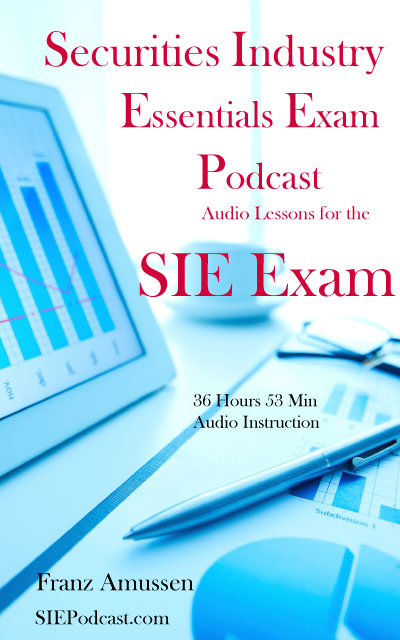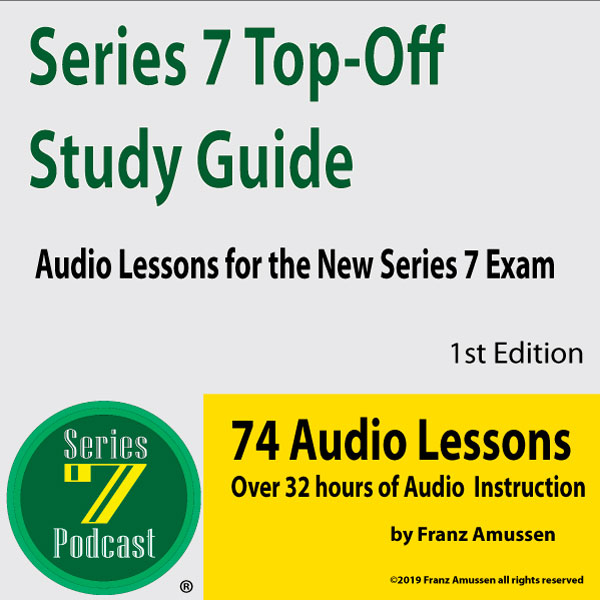Podcast: Play in new window | Download (Duration: 17:34 — 7.1MB)
This is a Series 7 Lesson 18 Free Quiz which is covering Common Stocks. Try it and see how you do if you need help listen to the lesson over.
Series 7 Lesson 18 Free Quiz
This is a Series 7 Lesson 18 Free Quiz which is covering Common Stocks. Try it and see how you do if you need help listen to the lesson over.
Questions covered include
1. In which of the following sections of the balance sheet is the common stock placed?
A. asset
B. equity
C. liability
D. revenue
2. A common stockholder owns a portion of the company.
A. True
B. False
3. Which of the following can issue common stock?
A. corporations
B. investment companies
C. both corporations and investment companies
D. neither corporations nor investment companies
4. A no par stock means ___.
A. the stock does not have voting rights
B. the stock does not receive dividends
C. the stock has a negligible or very low par value
D. the stock has no intrinsic value
5. Why do stocks have low par value?
A. A low par value allows more people to buy stocks and therefore increasing the company’s equity.
B. Lowering the par value also lowers the tax of the corporation.
C. The low par value ensures that the corporation issues only a sustainable amount of stock.
D. The New York Stock Exchange rules does not allow high par value.
6. These are shares that have been sold and then bought back by the company.
A. authorized shares
B. issued shares
C. outstanding shares
D. treasury shares
7. Which of the following is not included when computing for a company’s earnings per share?
A. authorized shares
B. issued shares
C. outstanding shares
D. treasury shares
8. The ___ handles the transfer of stock from an old stockholder to a new one.
A. bookkeeper
B. registrar
C. rights agent
D. transfer agent
9. Which of the following is true about the rights of a stockholder?
(Select all that apply.)
A. A stockholder has the right to vote at the company’s annual meeting.
B. The amount of votes that a stockholder has is determined by the number of shares he owns.
C. The stockholder has the right to buy shares of stock before they are offered to somebody else at the issue price.
D. The stockholder’s liability is limited to the value of his stocks.
Series 7 Lesson 18 Free Quiz: Common Stock Continued:
10. According to the New York Stock Exchange rules, which of the following does NOT require a stockholder vote?
A. clearance of a stock split
B. declaration of a reverse stock split
C. issuance of convertible bonds
D. purchase of treasury stock
11. Under the New York Stock Exchange rules, a stock dividend can be made by the decision of the Board of Directors as long as the stock dividend is less than ___.
A. 10%
B. 15%
C. 20%
D. 25%
12. Only those stockholders present at the annual meeting can vote.
A. True
B. False
13. A stockholder can change his vote on his proxy statement if he attends the annual meeting.
A. True
B. False
14. Which of the following does NOT allow different classes of common stock?
A. American Stock Exchange
B. NASDAQ
C. New York Stock Exchange
D. All stock exchanges allow for different classes of common stock.
15. According to the Securities Act of ___, a common stockholder has the right to inspect the record book of stockholders.
A. 1933
B. 1934
C. 1943
D. 1944
16. Which of the following are negotiable securities according to the New York Stock Exchange rules?
A. certificates of deposit
B. mutual funds
C. savings bond
D. transfer of ownership
17. A stockholder is not allowed to sell his right to buy a stock.
A. True
B. False
18. In the event of a corporate dissolution or bankruptcy, a common stockholder has the right to the corporate assets.
A. True
B. False
19. The normal settlement states that you need to own the stock and be an owner of record at least ___ business days before the record date in order to be a stockholder of record.
A. one
B. two
C. three
D. four
20. This is the right of a shareholder to maintain his proportionate ownership in a corporation.
A. cum right
B. ex-right
C. preemptive right
D. rights offering
We hope you did well on this Series 7 Exam Lesson 2 Free Quiz
The Series 7 Top-Off Study Guide Audio Lessons for the New Series 7 Exam is the most comprehensive set of audio lessons which is available for the preparation to take the New Series 7 Top off Examination the course consists of 74 lessons which amounts to 32 hours and 27 min. in total length. Audio lessons are a supplement and not a substitute for the book learning that you should also be doing. Audio lessons simply allow you to learn comprehend and reinforce what you should also be learning through normal studying methods such as attending classes, reading books, and taking practice quizzes.
The full table of contents for the Series 7 Top-Off Study Guide is located here
The New Series 7 Top- Off Study Guide Audio Lessons is 74 lessons and a Total Length 32 hours 27
New Series 7 Exam
The New Series 7 Content Outline provides a comprehensive guide to the range of topics covered on the exam, as well as the depth of knowledge required. The outline is comprised of the four main job functions of a general securities representative. The table below lists the allocation of exam questions for each main job function.
Major Job Functions Percentage of Test Questions Number of Test Questions
(F1) Seeks Business for the Broker-Dealer from Customers and Potential Customers 7% 9
(F2) Opens Accounts after Obtaining and Evaluating Customers’ Financial Profile and Investment Objectives 9% 11
(F3) Provides Customers with Information about Investments, Makes Suitable Recommendations, Transfers Assets and Maintains Appropriate Records 73% 91
(F4) Obtains and Verifies Customers’ Purchase and Sales Instructions and Agreements; Processes, Completes, and Confirms Transactions 11% 14
TOTAL 100% 125”
The five job functions of the new Series 7 General Securities Representative Exam will be:
“Seeks business for the broker-dealer through customers and potential customers”
“Evaluates customers’ financial status, financial needs and risk tolerance, and helps them identify their investment objectives”
“Opens accounts, transfers assets and maintains appropriate account records”
“Provides customers with information on investments and makes suitable recommendations”
“Obtains and verifies customer’s purchase and sales instructions, enters orders and follows up”
These five functions of the new series 7 exam are the same or substantially similar to ones on the current Series 7 exam. A notable change from the existing Series 7 exam is the addition of evaluating customer “risk tolerance.”
37 hours 10 Min of audio instruction to help you prepare for the Securities Industry Essentials Exam
59 Audio Lessons for Securities Industry Essentials Exam
13 Bonus Lessons about the finance industry
Securities Industry Essentials Exam Podcast Audio Lessons for the SIE Exam
The full course details:
37 hours 10 Min of audio instruction to help you prepare for the Securities Industry Essentials Exam
59 Audio Lessons for Securities Industry Essentials Exam
13 Bonus Lessons about the finance industry
Securities Industry Essentials Exam Podcast Audio Lessons for the SIE Exam
New Series 7 Exam and SIE Exam details.
All candidates now must now pass both the SIE exam (securities industry essentials exam) as well as the New Top-Off Series 7 Exam. A Series 7 candidate must also have an industry sponsor in order to take the examination to take the SIE Exam the candidate simply needs to be 18 years old and no broker affiliation is needed..
https://www.finra.org/industry/essentials-exam
- “Securities Industry Essentials (SIE) Exam
Available Beginning October 1, 2018
The Securities Industry Essentials (SIE or Essentials) Exam, available beginning October 1, 2018, is a new FINRA exam for prospective securities industry professionals. This introductory-level exam assesses a candidate’s knowledge of basic securities industry information including concepts fundamental to working in the industry, such as types of products and their risks; the structure of the securities industry markets, regulatory agencies and their functions; and prohibited practices.
Key Features of the Essentials Exam
________________________________________
• The Essentials exam is open to anyone aged 18 or older, including students and prospective candidates interested in demonstrating basic industry knowledge to potential employers.
• Association with a firm is not required, and individuals are permitted to take the exam before or after associating with a firm.
• Essentials exam results are valid for four years.
The Essentials Exam at a Glance
________________________________________
Number of Items 75
Format Multiple Choice
Duration 105 minutes
Passing Score 70%
Cost $60”
Min
 The full table of contents for the Securities Industry Essentials Exam Podcast Audio Lessons for the SIE Exam is located here
The full table of contents for the Securities Industry Essentials Exam Podcast Audio Lessons for the SIE Exam is located here
Effective October 1, 2018 Financial Industry Regulatory Authority (FINRA) changed the licensing of those that wish to work in the financial services industry. There is now a required prerequisite for most of the Licensing tests and this is the Securities Industry Essentials Exam
Securities Industry Essentials Exam is a new FINRA exam for prospective securities industry professionals. This introductory-level exam assesses a candidate’s knowledge of basic securities industry information including concepts fundamental to working in the industry, such as types of products and their risks; the structure of the securities industry markets, regulatory agencies and their functions; and prohibited practices.
Unlike the licensing exams such as the Series 4, 6, 7, 9, 10… which require the candidate to be employed by a member firm, Securities Industry Essentials Exam is open to anyone over the age of 18 including students and prospective candidates interested in demonstrating basic industry knowledge to potential employers.
Association with a firm is not required, and individuals are permitted to take the exam before or after associating with a firm.
Essentials exam results are valid for four years.
Check out our podcast for the SIE Exam
Here is a link to our other study products





